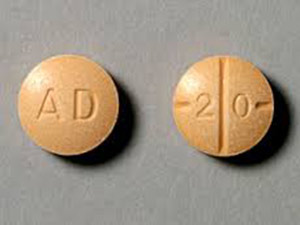|
|
 작성일 : 24-08-04 09:41
작성일 : 24-08-04 09:41
|
Buy Adderall Online - What is Adderall? What are its top benefits?
|
|
|
글쓴이 :
Patty (64.♡.58.104)
 조회 : 234
|
Adderall Pills and Mydayis[10] are trade names for a combination drug called mixed amphetamine salts ("MAS" products) containing four salts of amphetamine. The mixture is composed of equal parts racemic amphetamine and dextroamphetamine, which produces a (3:1) ratio (by weight) between dextroamphetamine and levoamphetamine, the two enantiomers of amphetamine. In terms of base, rather than salts, the ratio (by weight) is 3.15:1 for dextro- to levoamphetamine. Both enantiomers are stimulants, but differ enough to give Adderall an effects profile distinct from those of racemic amphetamine or dextroamphetamine, which are marketed as Evekeo and Dexedrine/Zenzedi, respectively. MAS is used in the treatment of attention deficit hyperactivity disorder (ADHD) and narcolepsy. It is also used illicitly as an athletic performance enhancer, cognitive enhancer, appetite suppressant, and recreationally as a euphoriant. It is a central nervous system (CNS) stimulant of the phenethylamine class.
 At therapeutic doses, MAS product causes emotional and cognitive effects such as euphoria, change in sex drive, increased wakefulness, and improved cognitive control. At these doses, it induces physical effects such as a faster reaction time, fatigue resistance, and increased muscle strength. In contrast, much larger doses of MAS product can impair cognitive control, cause rapid muscle breakdown, provoke panic attacks, or induce a psychosis (e.g., paranoia, delusions, hallucinations). The side effects vary widely among individuals but most commonly include insomnia, dry mouth, loss of appetite and weight loss. The risk of developing an addiction or dependence is insignificant when MAS is used as prescribed and at fairly low daily doses, such as those used for treating ADHD. However, the routine use of MAS in larger and daily doses poses a significant risk of addiction or dependence due to the pronounced reinforcing effects that are present at high doses. Recreational doses of MAS products are generally much larger than prescribed therapeutic doses and also carry a far greater risk of serious adverse effects. At therapeutic doses, MAS product causes emotional and cognitive effects such as euphoria, change in sex drive, increased wakefulness, and improved cognitive control. At these doses, it induces physical effects such as a faster reaction time, fatigue resistance, and increased muscle strength. In contrast, much larger doses of MAS product can impair cognitive control, cause rapid muscle breakdown, provoke panic attacks, or induce a psychosis (e.g., paranoia, delusions, hallucinations). The side effects vary widely among individuals but most commonly include insomnia, dry mouth, loss of appetite and weight loss. The risk of developing an addiction or dependence is insignificant when MAS is used as prescribed and at fairly low daily doses, such as those used for treating ADHD. However, the routine use of MAS in larger and daily doses poses a significant risk of addiction or dependence due to the pronounced reinforcing effects that are present at high doses. Recreational doses of MAS products are generally much larger than prescribed therapeutic doses and also carry a far greater risk of serious adverse effects.
The two amphetamine enantiomers that compose MAS product, such as Adderall Pills® tablets/capsules (levoamphetamine and dextroamphetamine), alleviate the symptoms of ADHD and narcolepsy by increasing the activity of the neurotransmitters norepinephrine and dopamine in the brain, which results in part from their interactions with human trace amine-associated receptor 1 (hTAAR1) and vesicular monoamine transporter 2 (VMAT2) in neurons. Dextroamphetamine is a more potent Central nervous system (CNS) stimulant than levoamphetamine, but levoamphetamine has slightly stronger cardiovascular and peripheral effects and a longer elimination half-life than dextroamphetamine. The levoamphetamine component of MAS has been reported to improve the treatment response in some individuals relative to dextroamphetamine alone. The active ingredient in MAS products, amphetamine, shares many chemical and pharmacological properties with the human trace amines, particularly phenethylamine and N-methylphenethylamine, the latter of which is a positional isomer of amphetamine. In 2021, MAS products, including Adderall Pills® brand, was the seventeenth most commonly prescribed medication in the United States, with more than 30 million prescriptions.
Long-term amphetamine exposure at sufficiently high doses in some animal species is known to produce abnormal dopamine system development or nerve damage, but, in humans with ADHD, long-term use of pharmaceutical amphetamines at therapeutic doses appears to improve brain development and nerve growth. Reviews of magnetic resonance imaging (MRI) studies suggest that long-term treatment with amphetamine decreases abnormalities in brain structure and function found in subjects with ADHD, and improves function in several parts of the brain, such as the right caudate nucleus of the basal ganglia.
Reviews of clinical stimulant research have established the safety and effectiveness of long-term continuous amphetamine use for the treatment of ADHD. Randomized controlled trials of continuous stimulant therapy for the treatment of ADHD spanning 2 years have demonstrated treatment effectiveness and safety. Two reviews have indicated that long-term continuous stimulant therapy for ADHD is effective for reducing the core symptoms of ADHD (i.e., hyperactivity, inattention, and impulsivity), enhancing quality of life and academic achievement, and producing improvements in a large number of functional outcomes[note 3] across 9 categories of outcomes related to academics, antisocial behavior, driving, non-medicinal drug use, obesity, occupation, self-esteem, service use (i.e., academic, occupational, health, financial, and legal services), and social function. One review highlighted a nine-month randomized controlled trial of amphetamine treatment for ADHD in children that found an average increase of 4.5 IQ points, continued increases in attention, and continued decreases in disruptive behaviors and hyperactivity.[43] Another review indicated that, based upon the longest follow-up studies conducted to date, lifetime stimulant therapy that begins during childhood is continuously effective for controlling ADHD symptoms and reduces the risk of developing a substance use disorder as an adult.
 Current models of ADHD suggest that it is associated with functional impairments in some of the brain's neurotransmitter systems;[45] these functional impairments involve impaired dopamine neurotransmission in the mesocorticolimbic projection and norepinephrine neurotransmission in the noradrenergic projections from the locus coeruleus to the prefrontal cortex. Psychostimulants like methylphenidate and amphetamine are effective in treating ADHD because they increase neurotransmitter activity in these systems. Approximately 80% of those who use these stimulants see improvements in ADHD symptoms. Children with ADHD who use stimulant medications generally have better relationships with peers and family members, perform better in school, are less distractible and impulsive, and have longer attention spans.[48][49] The Cochrane reviews on the treatment of ADHD in children, adolescents, and adults with pharmaceutical amphetamines stated that short-term studies have demonstrated that these drugs decrease the severity of symptoms, but they have higher discontinuation rates than non-stimulant medications due to their adverse side effects. A Cochrane review on the treatment of ADHD in children with tic disorders such as Tourette syndrome indicated that stimulants in general do not make tics worse, but high doses of dextroamphetamine could exacerbate tics in some individuals. Current models of ADHD suggest that it is associated with functional impairments in some of the brain's neurotransmitter systems;[45] these functional impairments involve impaired dopamine neurotransmission in the mesocorticolimbic projection and norepinephrine neurotransmission in the noradrenergic projections from the locus coeruleus to the prefrontal cortex. Psychostimulants like methylphenidate and amphetamine are effective in treating ADHD because they increase neurotransmitter activity in these systems. Approximately 80% of those who use these stimulants see improvements in ADHD symptoms. Children with ADHD who use stimulant medications generally have better relationships with peers and family members, perform better in school, are less distractible and impulsive, and have longer attention spans.[48][49] The Cochrane reviews on the treatment of ADHD in children, adolescents, and adults with pharmaceutical amphetamines stated that short-term studies have demonstrated that these drugs decrease the severity of symptoms, but they have higher discontinuation rates than non-stimulant medications due to their adverse side effects. A Cochrane review on the treatment of ADHD in children with tic disorders such as Tourette syndrome indicated that stimulants in general do not make tics worse, but high doses of dextroamphetamine could exacerbate tics in some individuals.
Narcolepsy
Narcolepsy is a chronic sleep-wake disorder that is associated with excessive daytime sleepiness, cataplexy, and sleep paralysis. Patients with narcolepsy are diagnosed as either type 1 or type 2, with only the former presenting cataplexy symptoms. Type 1 narcolepsy results from the loss of approximately 70,000 orexin-releasing neurons in the lateral hypothalamus, leading to significantly reduced cerebrospinal orexin levels; this reduction is a diagnostic biomarker for type 1 narcolepsy.Lateral hypothalamic orexin neurons innervate every component of the ascending reticular activating system (ARAS), which includes noradrenergic, dopaminergic, histaminergic, and serotonergic nuclei that promote wakefulness.
Amphetamine’s therapeutic mode of action in narcolepsy primarily involves increasing monoamine neurotransmitter activity in the ARAS. This includes noradrenergic neurons in the locus coeruleus, dopaminergic neurons in the ventral tegmental area, histaminergic neurons in the tuberomammillary nucleus, and serotonergic neurons in the dorsal raphe nucleus. Dextroamphetamine, the more dopaminergic enantiomer of amphetamine, is particularly effective at promoting wakefulness because dopamine release has the greatest influence on cortical activation and cognitive arousal, relative to other monoamines. In contrast, levoamphetamine may have a greater effect on cataplexy, a symptom more sensitive to the effects of norepinephrine and serotonin. Noradrenergic and serotonergic nuclei in the ARAS are involved in the regulation of the REM sleep cycle and function as "REM-off" cells, with amphetamine's effect on norepinephrine and serotonin contributing to the suppression of REM sleep and a possible reduction of cataplexy at high doses.
The American Academy of Sleep Medicine (AASM) 2021 clinical practice guideline conditionally recommends dextroamphetamine for the treatment of both type 1 and type 2 narcolepsy. Treatment with pharmaceutical amphetamines is generally less preferred relative to other psychostimulants (e.g., modafinil) and is considered a third-line treatment option. Medical reviews indicate that amphetamine is safe and effective for the treatment of narcolepsy. Amphetamine appears to be most effective at improving symptoms associated with hypersomnolence, with three reviews finding clinically significant reductions in daytime sleepiness in patients with narcolepsy. Additionally, these reviews suggest that amphetamine may dose-dependently improve cataplexy symptoms. However, the quality of evidence for these findings is low and is consequently reflected in the AASM's conditional recommendation for dextroamphetamine as a treatment option for narcolepsy.
 Available forms Available forms
Adderall Pills® is available as immediate-release (IR) tablets and extended-release (XR) capsules. Mydayis® MAS product is only available in an triphasic extended-release formulation. Adderall Pills XR is approved to treat ADHD for up to 12 hours in individuals 6 years and older and uses a double-bead formulation. The capsule can be swallowed like a tablet, or it can be opened and the beads sprinkled over applesauce for comparable absorption. Upon ingestion, half of the beads provide immediate administration of medication, while the other half are enveloped in a coating which must dissolve, delaying absorption of its contents. It is designed to provide a therapeutic effect and plasma concentrations identical to taking two doses of Adderall Pills IR four hours apart. Mydayis uses a longer-lasting triple-bead formulation and is approved to treat ADHD for up to 16 hours in individuals 13 years and older. In the United States, the immediate and extended-release formulations of Adderall Pills are both available as generic drugs. Generic formulations of Mydayis became available in the US in October 2023.
When you loved this informative article and you would like to receive more information concerning Adderall Generic i implore you to visit our web-site.
|
|
|